Delivering Hope
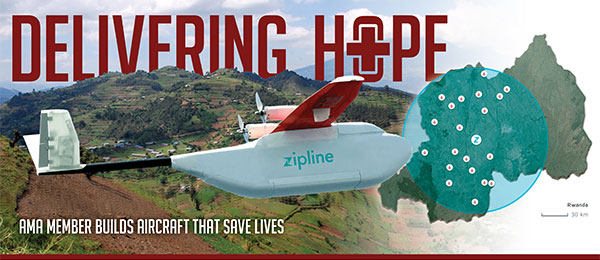
Written by Rachelle Haughn AMA member builds aircraft that save lives Photos provided by Zipline and Ronnie Romiti As seen in the September 2016 issue of Model Aviation.
Bonus video
“I just wanted to do something more fulfilling and things kind of fell into place.” Some people have desk jobs, some punch a time clock each day, and others work the night shift. At some point in life, people might wonder what purpose their jobs have in the greater scheme of things. In addition to earning a paycheck, are they making the world a better place? Even more important, are they changing lives? Longtime AMA member Ronnie Romiti, quoted above, no longer has to wonder what his answer to these questions would be. Not only is he able to apply the skills he learned through aeromodeling at work, he has a part in potentially saving the lives of people he’s never met. These men, women, and children live in remote areas of Rwanda, where delivering medical supplies to the sick and injured can be time-consuming and treacherous. The new delivery method for such supplies might not be what you would expect. Since July of this year, life-saving blood, vaccines, and medications are being delivered by an 8-foot electric-powered airplane with whimsical painted-on eyes, affectionately named Zip.
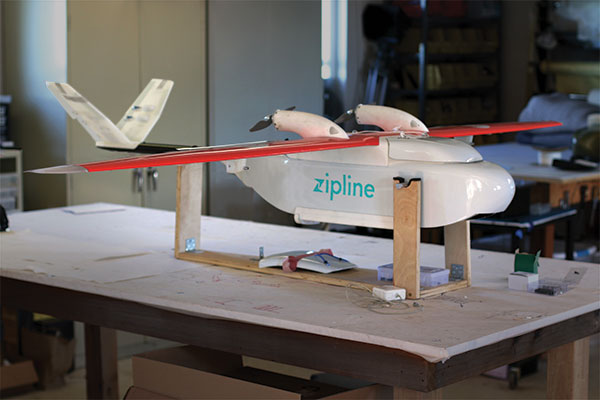
A Zip aircraft in the final stages of its assembly. These twin-motor airplanes are designed to carry a payload of up to 3.5 pounds and travel 80 miles roundtrip without needing a battery change.
This autonomous aircraft follows a predetermined flight path that takes it to a remote medical center. When it reaches the medical facility, a box of supplies that is attached to a paper parachute is released from the airplane and lands in a designated safe zone. The aircraft then returns to the location from which it was launched. “It’s very exciting,” Ronnie stated about working for Zipline, located off the California coast. “Every day is something new. We have a new problem to solve every day. Being in a startup [company] is extremely fast-paced.” In April, shortly after the company was announced to the public, Ronnie said he and his coworkers were concentrating on getting the Zipline to land in a smaller area that is roughly the size of a parking space. Keller Rinaudo, cofounder of Zipline, said he decided to hire Ronnie because of his unique skillset as an aeromodeler. “Ronnie has been building planes his whole life, so he has an amazing ability to improvise and just make things work in order to move fast to get vehicles flying fast. He’s a master prototyper, and has been involved in every single new airframe we’ve built as a company,” Keller said. “Ronnie is also an insanely talented test pilot, and was able to safely fly and land early prototypes of planes when no other pilots on the planet could.” When lifetime California resident Ronnie started working for the company in February 2015, he was the only employee with aeromodeling experience. Many of Ronnie’s coworkers at Zipline earned degrees at Harvard University, Stanford University, and Massachusetts Institute of Technology, and had worked for companies such as Google X, SpaceX, and Lockheed Martin. “I was very intimidated at first, but they are very nice to me. As much as they’re book smart … they still have a lot to learn about RC planes,” Ronnie stated about his coworkers. “We’re learning from each other.” Ronnie heard about the job opening through his aeromodeling club. When he applied for the position, he sent the company photos of aircraft he had built from kits and from plans. Because Zipline had not yet been publicly announced, when Ronnie went to the job interview he had to sign a nondisclosure agreement and meet company officials at a secret location. He brought along a Yellow Aircraft F-18 jet model that he had built, which seemed to make an impression.
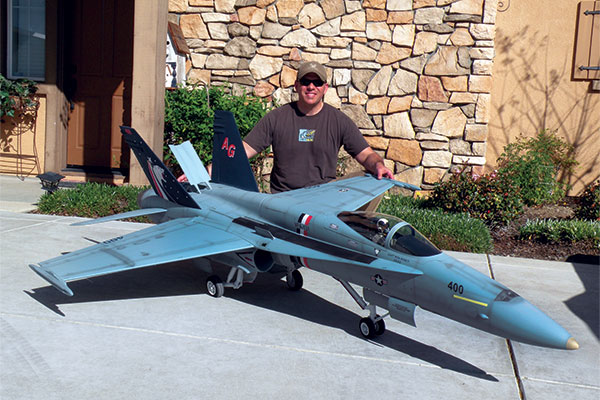
Ronnie Romiti’s experience in building model aircraft is one of the reasons why he was hired to work for Zipline. This Yellow Aircraft Twin F-18 is one of the jets that he has built and flies.
Before accepting the position, Ronnie had run his own construction company for many years. He applied for the job at Zipline because he felt like something was missing. That “something” has been fulfilled by Zipline. One of the first things that Ronnie had to teach his new coworkers was how to safely fly model aircraft. These lessons are the same ones that he learned more than 20 years ago when he began learning how to fly jets, Giant Scale electric-powered warbirds, and helicopters at a model aircraft club field. The safety tips that he gave his coworkers included the importance of establishing a flightline, to always fly with a spotter, and that they should never fly above people. Ronnie immediately dove into helping design a twin-motor aircraft that could carry a payload of up to 3.5 pounds, fly 80 miles roundtrip without changing the battery, and safely drop a box from 40 feet above ground. The aircraft he helped fine-tune weighs 22 pounds, can fly up to 60 mph, is safe to catch by hand, and is launched from a compressed-air catapult mechanism. “I wish I could tell people about the recovery system,” Ronnie commented. “It’s very cool!” In the developing stages, Zipline considered using quadcopters to deliver the medical supplies. Ronnie said these aircraft were candidates because they are readily available. The company soon realized the downside. “They’re much more difficult to make waterproof,” he said of multirotors. “They also don’t have the endurance for the range that we need,” he said, speaking in terms of battery power.
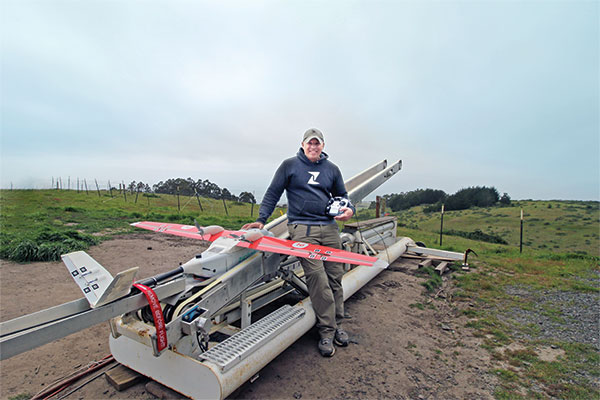
A Zip aircraft is ready to be launched by a large compressed-air catapult mechanism. The flight testing for the aircraft and launching system was done along the California coast.
“A lot of development went into making those airplanes waterproof,” Ronnie stated about the Zips (which also have been called fixed-wing drones—a term that he does not like). The aircraft had to be built to fly in strong wind at high altitudes. The higher the airplane must travel, the more battery power is used, he explained. Rwanda has unmanned aircraft regulations that are similar to those in the US. These include requiring unmanned models to be flown within line of sight. The Rwandan government, however, has made an exemption for Zipline. The Zips’ routes will be in areas that are designated as no-fly zones for other aircraft.
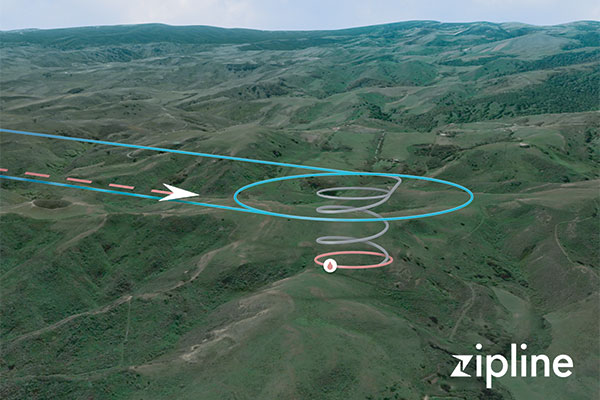
The autonomous Zip aircraft will have a set flight path, such as this one, that will be used to deliver medical supplies to clinics in Rwanda. The Rwandan government has made an exemption for Zipline to fly its aircraft in no-fly zones.
When Ronnie was first hired by Zipline, he was tasked with writing instructions for how to build the Zips, teaching others how to build and fly them, testing the motors and controls, and helping decide what components would be put into the aircraft. Ronnie said it was an honor to be an “RC guy” who was part of the company’s brainstorming sessions. “I’ve seen a lot of my ideas go into the [airframe],” he said. Before the first Zip made its maiden flight in Rwanda, Ronnie was busy building as many airplanes as possible. “The goal we are working up to is [to have] 50 to 150 flights per day, 15 planes [flying] a day, and a whole lot of batteries,” Ronnie commented. He is also the Zipline’s safety pilot and watches how the airplanes behave in flight. When Ronnie emailed Model Aviation about his new job, which he clearly loves, he wrote the following:
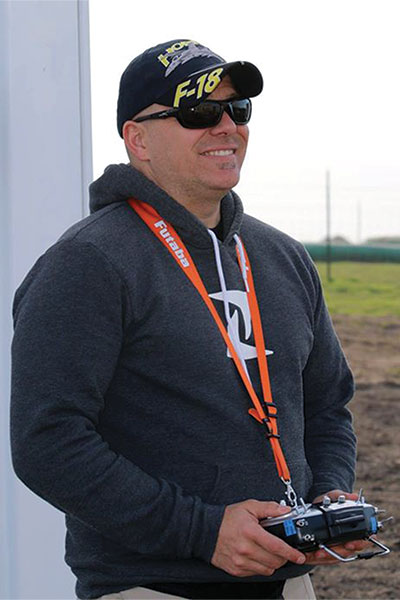
Ronnie enjoys having a career that allows him to build and test aircraft that could potentially save lives.
The positive is definitely the work that Zipline is doing in Rwanda, which Keller hopes will soon expand to other countries. “These supply chain challenges are not unique to Africa, and actually exist in countries around the planet. Our goal is to roll out Zipline systems in all of those countries to revolutionize how we deliver medical care to people who live in rural or remote locations,” Keller said.
“Zipline will ultimately allow the Rwandan government to put each and every one of the 11 million citizens of Rwanda within a 10- to 45-minute delivery of any essential medical product they could need.” When the aircraft were ready to be launched, Zipline’s focus moved to Rwanda, and some of its employees were stationed there to get everything set up and running. “Our nest will be located close to a regional medical center there, just down the street from us,” Ronnie explained in April. “We will have a cold chain to keep the blood cool.” The medical supplies come from the regional medical center, and then are sent out via Zip to other medical clinics and centers. Currently, motorcycles can navigate some of the rocky terrain, but Rwanda’s rainy season sometimes washes away roads with poor infrastructure, making them impassible for a motor vehicle. Delivering medical supplies via a motorcycle can take several days, Ronnie explained. With the help of Will Hetzler and Keenan Wyrobek, Keller has built Zipline into what it is today. Will was his roommate at Harvard for three years, and he met Keenan through a mutual acquaintance in 2014. Keller explained how the idea for Zipline, which was formed in 2011, came about. “We were spending time in several different countries in Africa, and realized that with the advent of cellphones, it’s now possible for doctors and health centers to text into a central system when they have a patient whose life is in danger, but they don’t have the medical product they need to help that person. “But the other half of that system doesn’t exist. It’s not possible for the existing medical supply chain to respond quickly, even when they have the product that person needs. So we wanted to build that half of the system, and make it possible for countries to respond to emergencies quickly and efficiently, even when a patient lives in a remote or hard-to-reach location.”
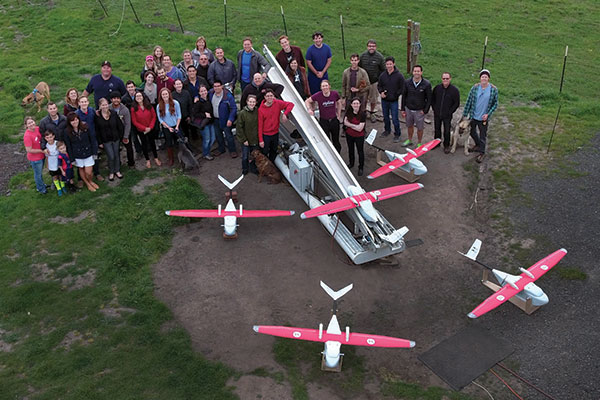
Some of Ronnie’s coworkers earned degrees at prestigious universities, but had never flown a model aircraft. He was honored to be able to teach them how to fly.
In Rwanda, text messages are sent to the regional medical center near Zipline’s base. The requested medical supplies are then taken to Zipline to be delivered. In 2010, approximately 58,000 women across Eastern and Southern Africa died during pregnancy and childbirth. The number of such deaths has slightly declined in the past few years, but getting more women access to the emergency care that they need is tricky in Eastern Africa. This is especially true in Rwanda, where the leading cause of maternal death is blood loss, according to a study by UNICEF. In addition to mothers, children in Rwanda might no longer die from from malaria. Vaccines for malaria will be delivered by Zips, Ronnie said. “Which is just crazy because [malaria is] totally preventable,” he added. “They just don’t have the medicine.” Ronnie said in April that he preferred to stay in California when the work in Rwanda began, but believed that he would be sent there for a short while. “I really hope that we’ll be a big success in Rwanda.” In his email to Model Aviation, Ronnie summed up the reason that he decided to share his story.
“I’m sure it won’t change everyone’s outlook overnight, but seeing drones used to save lives all around the world might have an impact. It’s been an amazing journey to this point and only promises to get better—a dream come true for a guy who just loves Remote Control planes.
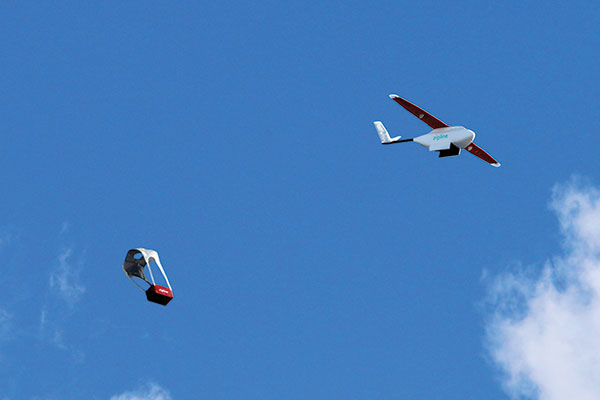
Zip airplanes have a hatch that opens underneath and releases a box of medical supplies that parachutes to the ground. The 22-pound Zip aircraft can fly up to 60 mph and are safe to catch by hand.
“I wanted to share the news to help spread the positive outlook for the future, at a time when we hear so much negative, and also to give hope to other hobbyist that dreams can come true. I have discovered that the old saying [about] when you do what you love, you never work a day of your life, is completely true!” —Rachelle Haughn [email protected]










4 comments
very nice WOW
Question
Hello Yosef,
Zip Line
Add new comment